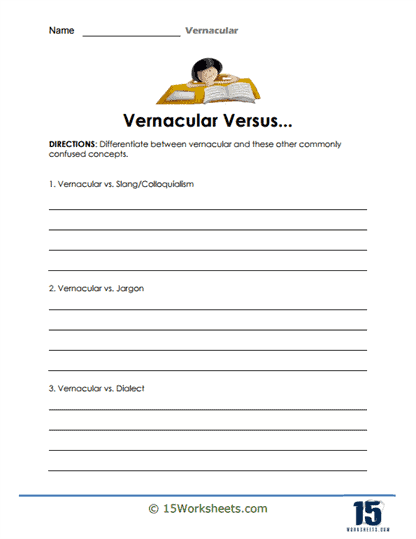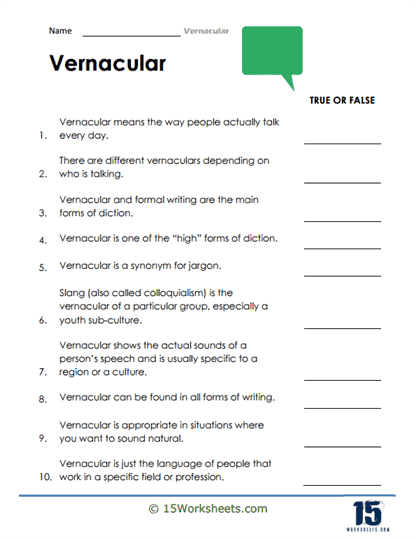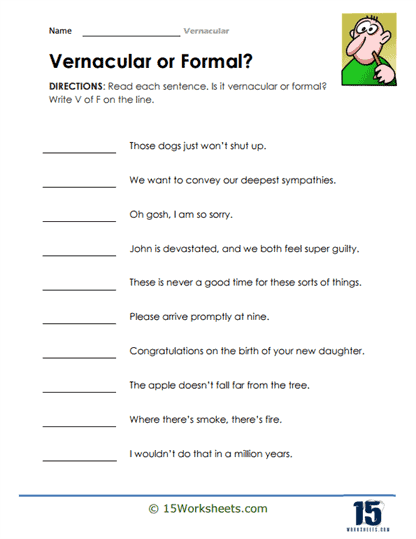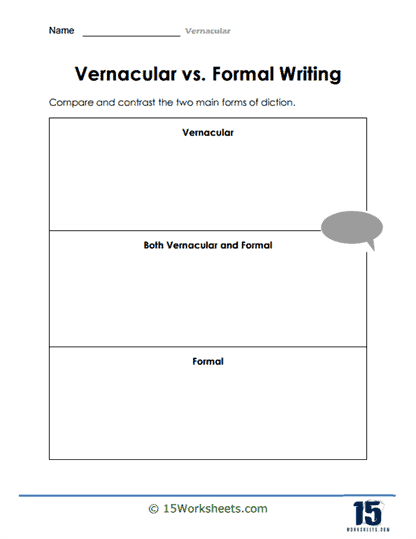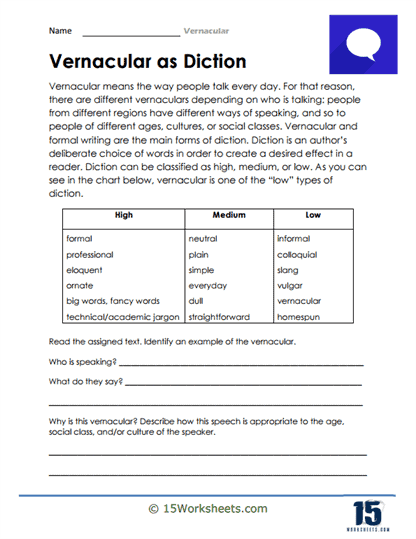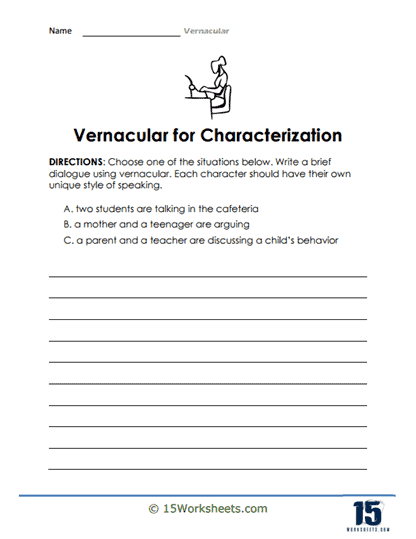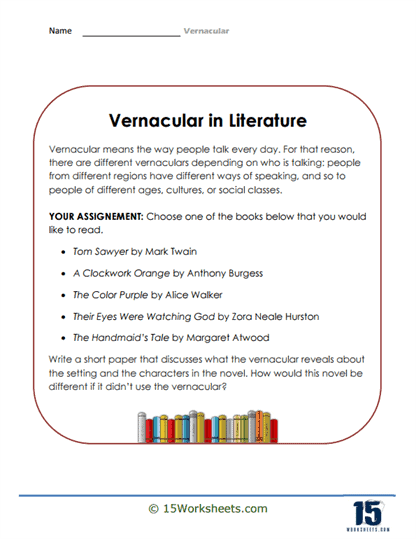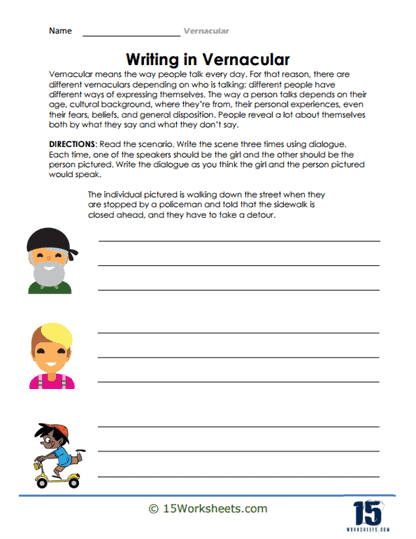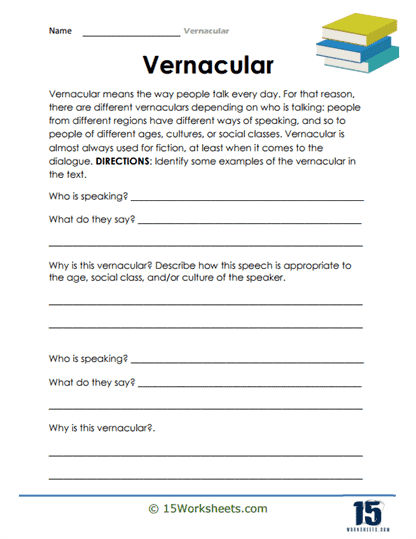Vernacular Worksheets
About These 15 Worksheets
These worksheets were created to help students grasp the intricacies of vernacular language, which refers to the dialect, slang, or non-standard linguistic expressions used by specific groups or regions. These worksheets aim to deepen students’ understanding of the cultural, social, and linguistic contexts that shape vernacular expressions, enhancing their language arts and reading skills through targeted exercises. By engaging with vernacular language, students not only appreciate linguistic diversity but also develop a nuanced understanding of language as a dynamic and culturally embedded phenomenon.
Through a diverse array of exercises, these worksheets not only enhance students’ linguistic skills but also broaden their cultural horizons, promoting a deep appreciation for the richness of linguistic diversity. By engaging with vernacular language, students develop a more comprehensive understanding of language as both a communicative tool and a cultural artifact, equipped with the skills and awareness necessary for effective and empathetic communication across diverse linguistic landscapes. The benefits of practicing with Vernacular Worksheets extend beyond academic achievement, fostering a lifelong appreciation for the beauty and complexity of language in all its forms.
Types of Exercises
Vernacular worksheets comprise a variety of exercises tailored to different learning objectives, each designed to facilitate students’ engagement with and understanding of vernacular language:
Identification and Matching – These tasks challenge students to identify vernacular expressions within texts or match them to their standard English equivalents. This fosters linguistic awareness and helps students recognize the diversity within languages.
Translation – Students are asked to translate sentences or short paragraphs from standard English into a specific vernacular and vice versa. This exercise not only enhances comprehension of vernacular expressions but also promotes flexibility in language use.
Contextual Usage Tasks – Here, students are provided with scenarios or dialogues where they must appropriately use vernacular terms. This strengthens their ability to apply vernacular language in context, enhancing their communicative competence.
Creative Writing Prompts – Encouraging the use of vernacular language in creative writing allows students to experiment with voice and perspective, fostering creativity and a deeper appreciation for linguistic diversity.
Comparative Analysis – Exercises that compare vernacular expressions across different regions or social groups highlight the socio-cultural factors influencing language. This analysis broadens students’ understanding of language variation.
Fill-in-the-Blank and Cloze Tests – These exercises require students to select appropriate vernacular expressions to complete sentences or passages, testing their understanding of vernacular usage and its contextual appropriateness.
Historical and Cultural Research Assignments – Students may be tasked with researching the origins, evolution, and cultural significance of specific vernacular expressions. This deepens their understanding of the historical and social dimensions of language.
The Benefits of These Worksheets
The use of these worksheets in language arts offers numerous benefits, contributing to a holistic understanding of language and enhancing various skills:
Improved Linguistic Flexibility – Exposure to vernacular language through these worksheets trains students to navigate between different language registers, improving their ability to adapt their language use to different contexts.
Enhanced Cultural Competence – Understanding vernacular language deepens students’ appreciation of cultural diversity and linguistic identity, fostering empathy and global awareness.
Broadened Vocabulary – Engaging with vernacular expressions enriches students’ vocabulary, providing them with a wider range of linguistic tools for expression and comprehension.
Increased Engagement with Texts – Learning about vernacular language can make literary texts, especially those that incorporate dialect or colloquial speech, more accessible and engaging, enhancing students’ reading experience.
Strengthened Analytical Skills – Analyzing the use and impact of vernacular language in various contexts sharpens students’ analytical abilities, enabling them to perform more nuanced textual analysis.
Creative Expression – By incorporating vernacular language into their own writing, students can explore new dimensions of expression and voice, enhancing their creative writing skills.
Language Awareness and Appreciation – Vernacular Worksheets highlight the dynamic and evolving nature of language, fostering an appreciation for the richness and complexity of linguistic expression.
What is the Literary Device of Vernacular?
The literary device of vernacular refers to the use of the everyday language spoken by people in a particular locality or belonging to a specific social group, instead of a more widely used, standardized, or formal language. This device enables authors to infuse their narratives with realism, authenticity, and depth, fostering a deeper connection between the reader and the text. Employing vernacular language can significantly enhance character development, setting, and thematic expression within a work of literature.
The main defining feature of vernacular is its reflection of the natural speech patterns, dialects, slang, and idiomatic expressions unique to a particular group or region. Unlike standardized language, which is often uniform and formal, vernacular is dynamic, richly textured, and deeply embedded in the cultural and social fabric of a community. It captures the nuances of local speech, including its rhythm, cadence, and colloquialisms, offering a more intimate portrayal of characters and their environments.
Vernacular in literature is characterized by several distinctive features:
Authenticity – It provides an authentic representation of the speech patterns and language unique to a specific group, lending credibility to characters and settings.
Cultural Specificity – Vernacular language is steeped in the cultural nuances and historical context of the group it represents, enriching the narrative with cultural depth.
Expressiveness – With its colloquialisms and idiomatic expressions, vernacular allows for a more expressive and nuanced conveyance of thoughts, emotions, and cultural values.
Diversity – It highlights linguistic diversity, showcasing the variety of human language and challenging the dominance of standardized forms.
Accessibility – For readers familiar with the vernacular used, the text may feel more accessible and engaging, as it mirrors their own manner of speaking.
Examples of Vernacular in Literature
“The Adventures of Huckleberry Finn” by Mark Twain – Twain’s use of vernacular language, particularly the dialects of the antebellum South and the Mississippi River Valley, stands as a seminal example of vernacular in literature. Through Huck’s first-person narrative, Twain authentically captures the speech patterns, slang, and regional idioms of the time, which serves to ground the novel in its setting and brings its characters to life with remarkable realism. This use of vernacular not only enhances the narrative’s authenticity but also underscores themes of race, identity, and social inequality, offering a critical commentary on the societal norms of the era.
“Their Eyes Were Watching God” by Zora Neale Hurston – Hurston employs African American Vernacular English (AAVE) to tell the story of Janie Crawford and her journey through three marriages in the early 20th century American South. The use of AAVE provides a powerful and authentic voice to the characters, particularly in dialogues, which allows Hurston to explore themes of identity, autonomy, and the African American experience with profound depth and authenticity. The vernacular language enriches the narrative with a sense of place and community, making the cultural and social milieu of the characters tangible to the reader.
“Trainspotting” by Irvine Welsh – Welsh’s novel, set in the late 20th-century Edinburgh, is notable for its extensive use of Scottish dialect. The vernacular language immerses readers in the world of the characters-disaffected youth immersed in the city’s drug scene-allowing for an unvarnished exploration of themes related to addiction, poverty, and friendship. The Scottish dialect not only authenticates the characters’ experiences but also challenges readers to engage with the text on a deeper linguistic level, enhancing the narrative’s impact and emotional resonance.
The Effect of Vernacular on the Reader
The use of vernacular in literature has a profound effect on readers, influencing their engagement with the text and the depth of their understanding:
Enhanced Realism and Immersion – By reflecting the way people actually speak, vernacular language enhances the realism of a narrative, allowing readers to immerse themselves more fully in the story’s world.
Emotional Connection – Vernacular can foster a stronger emotional connection to characters by presenting their speech and thoughts in a language that feels genuine and relatable, particularly for readers who share a cultural or linguistic background with the characters.
Cultural Insight – Through exposure to vernacular language, readers gain insight into the cultural, social, and historical contexts that shape the characters’ lives and actions, enriching the reading experience with cultural understanding and empathy.
Challenging Engagement – While vernacular language can make a text more accessible to some, it may also challenge readers unfamiliar with the dialect or slang being used. This encourages active engagement with the text as readers seek to understand the nuances of the vernacular language.



